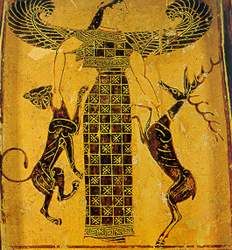

Artemis is the Greek goddess of the Hunt, equated with the Roman Diana (who will be featured at a later time) and the Etruscan Aritimi, Artimi, or Artumes. She has also been associated with the Celtic Artio of Muri. Though a Greek goddess, Artemis was known throughout western Asia. She is principally a goddess of animals and hunting, but in Greek-speaking Asia she was also a Mother-goddess.
Artemis is a deity of very ancient origins who was very popular in Asia Minor and Greece into early Christian times. She is considered a template upon which much the Virgin Mary worship was built, especially considering these two ‘virgin goddess’ shared a worship center in Ephesus (Turkey). Her other centers of worship were Antioch near Pisidia, Delos, Magnesia on the Meaender, Pamphylia, and Perge. On May 25th, her statue would be carried in a procession of up to 30,000 people.
To the Greeks, Artemis was the daughter of Zeus and Leto and twin to Apollo. She is a goddess of the moon and of silver. Her sanctuary at Delos is the site of the famous Horn altar dating from 700 BCE. She was known as Potnia Theron, “Mistress of the Animals.” In this aspect she suckled all the young of the world, but in her huntress aspect, she uses a bow and arrows. The Greeks depicted her as a young girl, roaming the hills and fields, hunting boars and hinds with her band of nymphs. Artemis loathed cities and disliked crowds. She punished those who killed more than they could eat. They would be thrown from their horses, lose their way in the woods, or be eaten by wild animals. Certain animals, lions, bears, wolves, and all kinds of wild birds, were particularly scared to her. She presided over the initiation ceremonies of young girls. While she was sometimes shown as hostile to those who gave up maidenhood for the role of wife, she was also a goddess to be called upon during birth.

As an Asian goddess, Artemis was depicted with wings and standing between wild animals. In these images, she was shown with boots, holding a torch and wearing a pointed cap. She was also a strongly androgynous figure, especially as depicted in her statue at Ephesus. Her temple there dates from the 4th century BCE and is considered one of the Seven Wonders of the World.
Aritimi has much in common with Artemis. She is the Etruscan goddess of night and death, but also the personification of growth in nature. Aritimi was called the Queen of the Moon and acted as the Goddess of the Chase and of Forests. She oversaw Childbirth, but might also bring sudden death to Women.